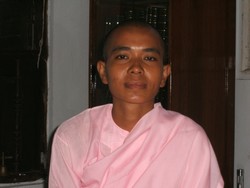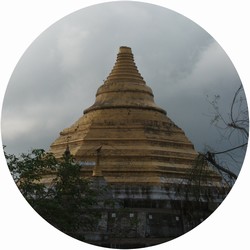SayaLay
Dear K, I wasn't feeling well and so this letter is late. Writing interests me, so I enjoy writing this letter. When you get this, it gets translated, and since lots of people can read it, there's even more reason to do it.
This time I will tell you about the young nun who came to my house 3-4 days ago. I have a friend who is close to me like a brother; he goes to meditate at the centre near by every day. He turned up at our house one morning. He's the one who was collecting donations (after Nargis) for constructing huts in a village near Ma-U-Bin. He had come to tell me that 50 huts had been completed. He said that there were cyclone survivors in his car, so I invited them up. One SayaLay (Little Guru/Teacher; the nun), a fifteen year old girl, and a ten year old. Before they came up, my friend told me that the two young ones had lost their parents in the cyclone.
I gave SayaLay some coffee, and interviewed her!
The fifteen year old was wearing nuns' orange clothes, she didn't have any of her own and was wearing SayaLay's. I searched around and gave the two some clothes. From amongst the clothes that I had gathered to give away, I gave SayaLay about 70 pieces.
SayaLay is only 35 years old. Her little nunnery is in South Dagon (near Yangon.) She comes to meditate at the centre near us and so had met my friend there. When the cyclone hit, she was on retreat at this centre. The cyclone also brought down her nunnery. (I was told over the phone last week that this nun had taken down to the Delta the wood and whatever she could salvage of her nunnery, to contribute to her village. On the way, the transport for the stuff was given to her for free at each stage of her journey.)
Her family is from Laputta District, from a village called MyitToe (Short River.) There were about 800 households there. The cyclone destroyed all but twelve houses. More than 500 people died. Now they are rebuilding their houses. It's a place where every year there is high water, they are used to flooding.
SayaLay's father, with some family members, seven of them, were all at the hut in their paddyfields at the time the cyclone hit. He was 73 years old. About 9pm (on 2 May), the waters started to rise. Rain and wind came, and when the waters slowly rose higher and higher, the father took the containers of ngan-pya-ye (fish sauce, Namplaa in Thai) and threw out their contents. In this area, there is a lot of fish sauce and so they had two large plastic containers in the hut. He put his arm through the handle of the plastic container, clinging on to it. Another person did the same with the other container, and with their hands linked, they were carried about in the waters. After a long time like this, the father said that this was not going to work, and told them to let go. He freed his hold first from the linked circle. The plastic container he had been clinging to was left with his niece. The old man was carried away. His body has not been recovered.
One niece with her good karma did not float out to sea. She was carried into the river, she floated for two nights in five rivers, eventually got carried towards the fields and when the waters ebbed, she was left deposited on land. After she threw up the water that she had swallowed and came to, she saw that she was naked. Some rescuers found her, and so her life was saved.
The mother's good karma carried her to a large clump of water hyacinths, they had formed a huge mat which supported her; she was eventually spotted by someone so she didn't die. It was a river motorboat that came by. She is 72 years old.
 SayaLay
went back to her village on the
6th day after the cylone, the survivors told her what had
happened. She found out that on the 4th day after
the cyclone, those who could went in the local boats
to look for other survivors. More than two rivers away, the
bodies of two of her family members were
found.
SayaLay
went back to her village on the
6th day after the cylone, the survivors told her what had
happened. She found out that on the 4th day after
the cyclone, those who could went in the local boats
to look for other survivors. More than two rivers away, the
bodies of two of her family members were
found.
K, think how pitiful people here in Burma are! In foreign countries, if you are carried away in the waters one night, the next day helicopters go out to look for you. Here we don't have many helicopters, and if after four days, people must go out searching for you in a little local boat, how can you be still alive by the time they find you?
A lot of people died from the water and the wind. Just as many must have died because there was no one to save them.
There must have been lots of tiny villages with 200-300-400 households which were situated close to the sea, beaten by winds and waters, which have entirely disappeared. Even us (in Yangon), we didn't know of the existence of these little villages along rivers and streams. SayaLay brought a list of destroyed villages, on just her list, there are more than 30 villages, K!
What she said is this : those places that can be reached by car are swarming with assistance. Those places where people are going to give help are all reachable by car. To those places which require journeys by boat, in this time of winds and rain, not many people will go. I too am afraid of water. Even the journeys by car, the roads are so terrible that I don't want to go. The pot-holes are now filled with water, you can't tell if they're small or enormous. If you take the train, you think your innards are going to be wrenched out of you. The train jumps up and down, sways and hits the sides. Only by air I want to travel. I want to get on a plane and go abroad. Why don't you send me a helicopter?
a message from Kinthissa : people in Yangon, even those relatively well-off, are feeling the hardships that have increased since the cyclone. The monsoons are very heavy this year.
To make journeys by water is daunting, it is taking your life in your own hands. Some help is continuing to be given to those villages reachable only by water, but the fact is, it needs organised assistance with good boats, helicopters and the like. Not the kind of help ordinary citizens can give.
And there are constant scares - if you give help without first asking the authorities, there will be difficulty. But city people are still going to the Delta. The nun mentioned in my friend's letter is going back to the area in the Delta that she comes from. She has lost most of her family, and is committed to helping people in other villages. Part of the roofing material she will be taking down this week is from our contribution. We will be hearing more of her, I hope.
Part of the down in Yangon is the loss of people's satellite dishes in the cyclone. News and contact with the world is a life-line for people there. They depend on international broadcasts. Apart from prohibitive price rises, there is now stronger control - the papers are saying, those who come to buy new satellite dishes will be arrested; those who sell them will be arrested.
The letter of May 31st is the first from a young woman doctor, she had been on the BetelNut Village trip as well. Both times we were able to contribute to the medical supplies.
These trips, especially those by water, are punishing. These boats - what I translate as 'motorboats', they are ordinary local boats with an engine attached - are not how you may imagine them.
I must ask her, were they able to stay dry during the 2 hour journey there, and another 2 hours back? Even a good boat in the monsoons would be battered about.
Do you remember, I mentioned the wonderful earthenware jars made around Twante? They are used all over the country. There was one miraculous survivor ~ a child put inside such a jar, and when the waters rose higher and higher, the jar floated up, out of reach of the mother. The child survived.

